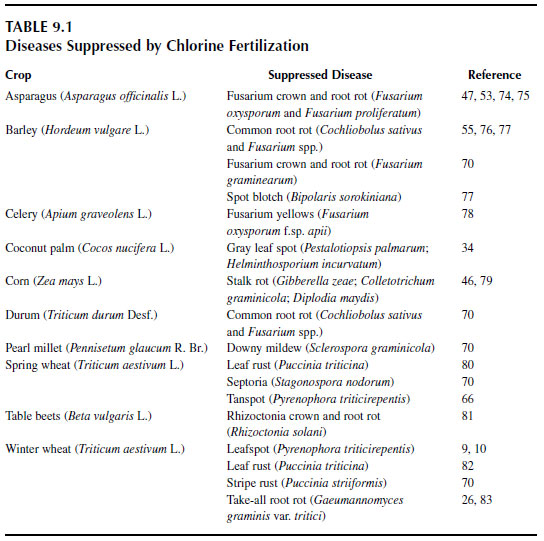Symptoms of Deficiency
Visible deficiency symptoms for chlorine have been well characterized in several crops by growth of plants in chlorine-free nutrient solutions (1,7,8,10). The most commonly described symptom of chlorine deficiency is wilting of leaves, especially at the margins. As the deficiency becomes more severe, the leaves may exhibit curling, shriveling, and necrosis (Figure 9.1A). Roots of chlorinedeficient plants have been described as stubby with club tips. Deficiency symptoms of chlorine are not commonly exhibited visually in most crops growing in the field, but symptoms are sometimes observed in wheat and coconut palm (Cocos nucifera L.). In chlorine-deficient wheat, the symptoms are expressed as chlorotic or necrotic lesions on leaf tissue (Figure 9.1B). These symptoms that result from chlorine deficiency have been named ‘Cl-deficient leaf spot syndrome’ (9,10). It has also been shown that bromide (Figure 9.1C) does not substitute for chloride in the prevention of deficiency symptoms (10). In coconut palm, the symptoms are exhibited as wilting and premature senescence of leaves, frond fracture, and stem cracking and bleeding (34). |
| FIGURE 9.1 (A) Wheat (Triticum turgidum L. Durum Group) grown with chloride added at 30 mmol in 15 liters of nutrient solution (0.002M KC1); (B) Wheat grown in the absence of halide; (C) Wheat grown in absence of chloride and with 1.5 mmol bromide in 15 liters of nutrient solution (0.0001M KBr). Photographs from Engel et al., (9). |
Chlorine deficiency is also indicated by yield increases that may occur with various crops in response to chloride fertilization. Wheat and barley often respond to chloride fertilization with increases in grain yield on soils with low chloride on the Great Plains of North America (2,35–41). Corn exhibited no response to chloride fertilization in some studies (2,42–44), but in a high-yield environment in New Jersey, fertilization of corn with 400 kg Cl ha-1 increased the 5-year average yield by 1000 kg ha-1 over the unfertilized control (45,46). Positive responses from chloride fertilization have also been observed with rice (Oryza sativa L.), sugarcane (Saccharum edule Hassk.), potato (Solanum tuberosum L.), kiwifruit (Actinidia deliciosa A. Chev.), coconut palm, sugar beet, and asparagus (Asparagus officinalis L.) (2,47). These responses indicate that chloride is sometimes a yield-limiting nutrient in field environments where chlorine inputs from rainfall and other natural sources are inadequate.
The beneficial effects of chloride fertilization are sometimes not the result of a plant response directly to enhanced chloride nutrition, but rather may result from suppression of plant diseases. Addition of chloride has been reported to reduce the severity of at least 15 different foliar and root diseases on 11 different crops (Table 9.1). Several possible mechanisms may explain the effects of chloride nutrition on disease suppression and host resistance.
In acid soils, chloride inhibits nitrification (48,49). Keeping nitrogen in the ammonium form can lower rhizosphere pH and influence microbial populations and nutrient availability in the rhizosphere (31,50). Competition between chloride and nitrate for uptake also tends to reduce nitrate concentrations in plant tissues (4,51). When plants take up more ammonium and less nitrate, it usually causes rhizosphere acidification, which in turn, may enhance manganese availability (52). Chloride can also enhance manganese availability by promoting manganese-reducing microorganisms in soil (53). Factors which increase manganese availability have been associated with improved host resistance to diseases such as take-all on grain crops (54). Higher concentrations of chloride in plant tissues can also enhance water retention and turgor when roots have been attacked by pathogens (26). The amount of organic acids, such as malate, in plant tissues and exuded from roots, decreases with chloride supply; this action deprives pathogens of an organic substrate (55).
 |




